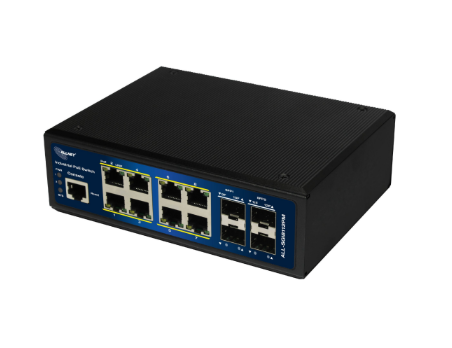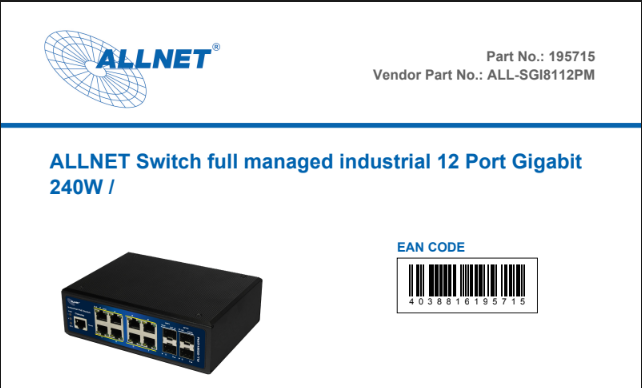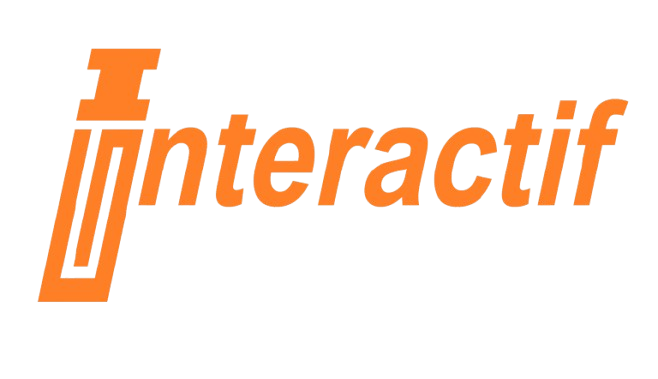edge switches

ALLNET Switch full managed industrial 12 Port Gigabit 240W /
PRODUCT DESCRIPTION
- 8 Gigabit ports with PoE AF-AT support, up to 30W per port
- 4 SFP ports for fiber Gbics (e.g., ALL4750-INDU / ALL4751-INDU)
- PoE Ports 1-8 support max. IEEE802.3at PoE at 30W
- Layer 2+ features include 802.1Q VLAN, Port Isolation, IGMP, LLDP, PoE+ Management, IP Source Guard, ACLs, etc.
- Supports Spanning Tree STP (802.1D), RSTP (802.1W), and MSTP (802.1s)
- Supports PoE management like PoE scheduling, PoE PD-alive, Port PoE Priority, Soft-Reboot PoE Non-Stop
- Supports G.8032 quick ring protocol with self-healing <20ms
- Max. PoE budget = 240 watts
- Fanless metal housing with optimized heat dissipation

ALLNET Switch full managed industrial 12 Port Gigabit 240W / 8x PoE+ / 4x SFP / Fanless / DIN / "ALL-SGI8112PM"
- 8 Gigabit ports with PoE AF-AT support, up to 30W per port
- 4 SFP ports for fiber Gbics (e.g., ALL4750-INDU / ALL4751-INDU)
- PoE Ports 1-8 support max. IEEE802.3at PoE at 30W
- Layer 2+ features include 802.1Q VLAN, Port Isolation, IGMP, LLDP, PoE+ Management, IP Source Guard, ACLs, etc.
- Supports Spanning Tree STP (802.1D), RSTP (802.1W), and MSTP (802.1s)
- Supports PoE management like PoE scheduling, PoE PD-alive, Port PoE Priority, Soft-Reboot PoE Non-Stop
- Supports G.8032 quick ring protocol with self-healing <20ms
- Max. PoE budget = 240 watts
- Fanless metal housing with optimized heat dissipation
- Versatile mounting options: desktop, wall mount, or DIN rail
- Extended temperature range from -40°C to +75°C
The ALL-SGI8112PM Industrial Switch is a Layer 2+ managed Gigabit PoE Switch designed specifically for heavy industrial environments. It features both Gigabit Ethernet and fiber optic ports, ensuring reliable and high-speed data transmission. The switch is housed in an IP40 rugged case with a redundant power system, offering robustness suitable for industrial applications. It includes advanced management interfaces for IPv6/IPv4 and features like Soft-reboot PoE Non-stop, making it an ideal choice for expanding or upgrading industrial network infrastructure.
FEATURES
- Supports L2+ Switching features including 802.1Q VLAN, Mirroring, Port Isolation, IGMP Snooping, DHCP Snooping, LLDP, PoE+ Management, IP Source Guard, ARP Inspection, ACLs, etc.
- Supports Spanning Tree STP (802.1D), RSTP (802.1W), and MSTP (802.1s)
- Enhanced management through WEB, CLI, Telnet, SSH, SNMP
- Supports cable diagnostics
- Dual firmware backup
- PoE management support: PoE scheduling, PoE PD-alive, Port PoE Priority, Soft-Reboot PoE Non-stop
- Supports G.8032 quick ring protocol with self-recovery time <20ms
- Supports IEEE1588 v2, transparent clock (TC)
- Supports DDM (SFP digital diagnostics monitoring)
- IPV4 and IPV6 static routing functions supported
- Memory and CPU monitoring capabilities
- 6KV surge protection, 6KV contact / 8KV air ESD protection
ATTRITUBES
- Anzahl Ports PoE/LAN: 8 PoE / 4 LAN
- Belüftung Switch: Lüfterlos (Fanless)
- Einsatzort Switch: Industrial DIN
- LAN Geschwindigkeit: 1 Gbit/s
- Management: Full Managed
- PoE Budget: < 300 Watt
- PoE Port Leistung: 30W at
- SFP Geschwindigkeit: SFP 1 GBit
- Weight: 0.5 Kg
- Warranty: 36 Months
ADDITIONAL IMAGES

Accessories
- 128033: ALLNET Switch Modul ALL4750-INDU SFP (Mini-GBIC), 1000Mbit, SX/LC, Industrial -40/+85 Grad
- 128034: ALLNET Switch Modul ALL4751-INDU SFP (Mini-GBIC), 1000Mbit, LX/LC, 10Km, Industrial, -40/+85 Grad
- 134034: ALLNET Power-Booster 24VDC to 48~55VDC max. 95W DIN Industrial ALL-B100-24VDC
- 140523: Synergy 21 Netzteil – 48V 75W Mean Well Hutschiene, schmal
- 140522: Synergy 21 Netzteil – 48V 120W Mean Well Hutschiene, schmal
- 131244: Synergy 21 Netzteil – 48V 240W Mean Well Hutschiene
- 146994: Synergy 21 Netzteil – 48V 480W Mean Well Hutschiene
- 140955: TP (RJ45) POE-Tester, at/af, Endspan/Midspan, standard, Synergy 21
- 148333: ALLNET 19″ zbh. Gerätehalter für Hutschiene/DIN-Rail Geräte, T150mm/5HE, Lichtgrau, Frontmontage
specifications
TECHNICAL DETAILS
Request a Quote
Learn More From
Frequently Asked Questions
Multimode fiber commonly comes in 50/125 μm or 62.5/125 μm core/cladding dimensions, with bandwidth capacities ranging from 200 MHz to 2 GHz, depending on the grade. Multimode systems typically support transmission distances of up to 5 km, making them suitable for short- to medium-range applications.
In contrast, singlemode fiber—usually 9–10/125 μm—offers significantly lower attenuation and effectively unlimited bandwidth, supporting links over 150 to 200 km, especially when paired with optical amplifiers and advanced transceivers.
While singlemode fiber is less expensive per meter, its associated transceivers and equipment tend to cost more than their multimode counterparts. That said, singlemode devices are generally compatible with both singlemode and multimode fiber, whereas multimode equipment works only with multimode fiber.
Let me know if you’d like this turned into a quick-reference table or visual comparison—it’d make a solid inclusion for a fiber deployment guide.
The link budget is the difference between the transmitter’s output power and the receiver’s sensitivity. This budget must account for all signal losses along the path, including:
- Fiber attenuation due to the transmission medium
- Connector losses, such as those at patch panels or equipment interfaces
- Splice losses from mechanical or fusion joints
- Link margin, which provides a buffer for unforeseen variations
The link margin typically ranges from 2–3 dB in tightly controlled environments to up to 10 dB in more variable conditions. It is designed to accommodate:
- Component aging (e.g., light sources may degrade and lose up to 3 dB over time)
- Temperature variations affecting transmitter output or receiver sensitivity (up to 3 dB may be needed for thermal fluctuations)
- Physical cable damage and repair-induced losses (usually minor, but more relevant in harsh or industrial settings)
Always design your system for worst-case scenarios to ensure reliability. However, don’t overlook the best-case condition either—some optical receivers may exhibit erratic behavior if the incoming signal is too strong.
First, verify the optical signal strength along the link. Use an optical power meter to measure the received power at the fiber’s end point. Typical transmit levels range from –8 dBm to –15 dBm, while the receiver sensitivity is around –31 dBm, giving you a link budget of approximately 16 dB. This margin supports transmission distances of up to 10 km on singlemode fiber and about 3–5 km on multimode fiber.
If the measured power falls below the receiver sensitivity, there’s a strong likelihood of issues with the installed fiber. Ideally, initial OTDR readings should have flagged such faults.
If not, inspect the patch cords currently in use for possible defects or misalignment. A frequent oversight is the use of mismatched patch cords.
Multimode fiber types are classified by the ISO/IEC 11801 standard into five main categories: OM1, OM2, OM3, OM4, and OM5. Each type differs in core size, bandwidth, supported data rates, and maximum transmission distances. Here’s a quick breakdown:

- OM3 and OM4 are laser-optimized and widely used in modern data centers.
- OM5 supports shortwave wavelength division multiplexing (SWDM), enabling multiple wavelengths over a single fiber for higher capacity.
- All OM types are backward compatible in terms of connectors, but mixing core sizes (e.g., OM1 with OM3) can cause performance issues.
